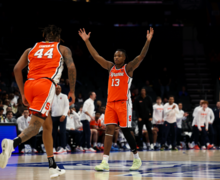Rock and Roll Hall of Fame? More like Hall of Same
The 2017 inductees for the Rock and Roll Hall of Fame were just announced, and with that announcement comes the annual onslaught of debate that surrounds the Hall.
This is not unprecedented — the Hall does have a number of flaws that should be addressed. While we can celebrate another year of the beloved institution that rewards the acts responsible for making the music we have come to worship as a culture, it is worth discussing its antiquated practices and homogeneous nature.
Every year, the Rock and Roll Hall of Fame nominating committee meets in New York City, and its members decide which acts to place on the election ballot. This committee is made up of critically-acclaimed people in the music world: musicians, record executives, writers and historians.
Each of the 41 people on the nominating committee can pick 3 acts and following discussion cast a secret ballot of 10 favorites. The 15 acts that receive the most votes are placed on a different ballot, which is then sent to the higher-ups, a committee of about 810 people. Once the ballots are returned and counted, the seven acts with the most votes are inducted, unless any of those acts lack enough support, which would then result in elimination.
Artists become eligible 25 years after their first recording. This year’s inductees are Electric Light Orchestra, Joan Baez, Journey, Pearl Jam, Tupac Shakur and Yes. With one woman and one rapper, this selection is more inclusive than usual — but historically, that has not been the case.
With the 25-year rule, the committee has begun to face the ’90s, which is when music stopped being unanimously classified as rock. From the ’90s, music split into various subgenres, such as pop, hip-hop, alternative, metal and rap. Despite this, most Hall of Fame inductees are still guitar-heavy, stereotypical classic rock acts.
Even pre-90s acts that dared deviate from the norm, such as The Cure and The Smiths, both crucial post-punk pioneers, have still remained without induction, despite being eligible since the early 2000s. LL Cool J has been nominated a number of times, but has never lasted all the way to induction. Carole King, one of the pioneers of the ’70s soft rock movement, still has yet to be inducted.
This can be mainly attributed to the old, white, rich male population of the nominating committee. These members are more conservative and overlook popular and deserving rap and pop acts. Since they make up the majority, their opinion overpowers dissenting ones. Acts that had been historically looked over again and again only ever reached induction with the help of newer members, who offered a fresh outlook on these repeatedly overlooked bands and helped sway the majority — including Kiss and Hall & Oates.
Out of the 41 members of the nominating committee, only seven are people of color, and only six are women. The youngest members are, or are approaching, 50 years old. This is the fundamental issue of the nomination process. The lack of diversity not only colors race and gender, but age as well.
However, if the committee makes efforts toward diversifying itself, welcoming younger members as well as more women and people of color, the Rock and Roll Hall of Fame will be a more accurate reflection of the history and progression of the rock and roll genre and all of its subgenres, rather than the biased, one-dimensional portrayal we have currently. If we continue with the system we have in place right now, the Hall is bound to diminish in relevance and die out with the people who run it.
Jenny Bourque is a freshman English and textual studies major. Her column appears weekly in Pulp. You can email her at jabourqu@syr.edu.
Published on January 31, 2017 at 11:45 pm





